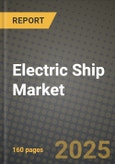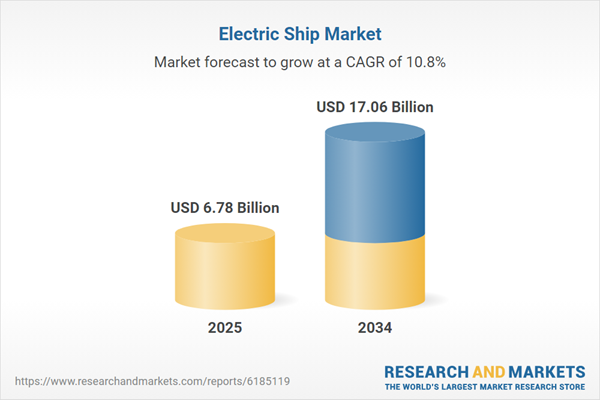Electric Ship Market
The Electric Ship Market covers vessels whose main propulsion (or significant onboard power systems) are either fully electric or hybrid‑electric (battery, fuel‑cell, shore‑charge enabled) rather than conventional internal‑combustion marine engines alone. These vessels span passenger ferries, short‑sea/coastal cargo ships, inland‑waterway craft, offshore service vessels, navies/defence platforms, and retrofits of existing fleets. Core applications include zero‑emission urban ferry routes, harbor operations, coastal freight corridors, offshore support logistics (oil & gas), and decarbonising newbuild fleets in line with the International Maritime Organization (IMO) and regional emission‑reduction mandates. Latest trends include: large‑battery capacity vessels launching (e.g., ferry with 40 MWh battery); shore‑power charging infrastructure development in ports; standardisation of marine battery systems and modular electric‑propulsion pods; hybridisation of legacy fleets via battery + ITS (in‑trail charging) rather than full conversion initially; and rising OEM/supplier consolidation around propulsion, energy storage and digital energy‑management systems. Drivers include increasingly stringent marine‑emission and carbon‑intensity regulations, cost‑competitiveness of battery‑electric systems in short‑haul/harbour operations, growth of electrified ferry and inland shipping in urban/eco‑tourism contexts, and global industry drive toward sustainability credentials. The competitive landscape features large marine‑engineering and power‑systems firms (e.g., ABB, Wärtsilä, Corvus Energy) offering integrated electric‑ship systems, specialist battery/energy‑storage providers, ship‑yards adopting electric‑design modules, and retrofit specialists converting existing vessels. Other considerations include: infrastructure readiness (charging networks, grid capacity at port); battery cost, lifecycle and safety in marine environments; vessel range and downtime constraints for full‑electric versus hybrid; and regional variability (many emerging markets remain reliant on conventional propulsion for cost/supply reasons). In sum, the electric ship market is at a strong inflection point: while full‑fleet replacement is still in early stages, numerous near‑term opportunities exist in ferries, short‑sea shipping and retrofit programmes, making this a key growth area in maritime decarbonisation.Electric Ship Market Key Insights
- Regulatory impetus is a key accelerator
- Short route and harbour/river use cases lead adoption
- Battery cost, energy density and safety remain constraints
- Hybrid and retrofit pathways provide transitional momentum
- Infrastructure readiness (shore charging, grid) is a bottleneck
- Commercial competitiveness improves as total cost of ownership (TCO) benefits emerge
- Large battery “flagships” shift perception and unlock scale
- Regional divergence in adoption pace
- Supply chain and manufacturing shifts required
- Potential for new business models and services
Electric Ship Market Reginal Analysis
North America
In North America, the electric ship market is gaining traction particularly in passenger ferry operations, inland waterways and pilot‐boat sectors. Emission regulations at the federal and state level (especially in California, New York) as well as port‑authority pressures support uptake. However, large ocean‑going vessels remain largely conventional, meaning near‐term growth is concentrated in smaller vessels and retrofit programmes. Owners prioritise TCO reduction and early mover advantages, while shipyards and integrators develop modular electric‐propulsion lines. Financial incentives (state‑funded demos, carbon credits) further accelerate adoption.Europe
Europe is one of the fastest‑growing continents for electric ships, thanks to mature maritime‑clusters, stringent EU decarbonisation policy (e.g., Fit for 55, clean‑fleet mandates) and strong port infrastructure. Northern Europe (Norway, Sweden, Netherlands) leads with electric ferries, coastal vessels and hybrid new‑builds; retrofit of legacy vessels is also active. The supply chain is advanced: shipping‑yard, battery, electric‑drive and integration expertise converge here. While full‑ocean‑going electric ships are still rare, short‑sea and inland segments are very active.Asia‑Pacific
Asia‑Pacific offers high growth potential due to large ferry and short‑Sea networks (China, Southeast Asia), ambitious infrastructure investment, and rising environmental regulation in major ports (Singapore, Shanghai). Nonetheless, infrastructure maturity varies, vessel sizes tend to be larger (posing battery‑size challenge), and cost‑sensitivity is higher. Local shipyards are beginning to offer electric/hybrid new‐builds and some retrofit programmes are emerging; but volume adoption is still nascent compared with Europe.Middle East & Africa
In the Middle East & Africa region, electric ship penetration is at early stages but shows promise in urban ferry routes, tourism and luxury yacht segments, and port‑authority demonstration projects. High ambient temperatures, unique marine operating conditions, and a legacy of fossil‑fuel shipping pose challenges. Infrastructure investments (port electrification, renewable grid tie‐ins) will be key. Growth may initially come via new build premium vessels in resort areas or commissioned by national flagship programmes.South & Central America
In South & Central America, the electric ship market is emerging, supported by urbanisation (ferries across rivers, lakes), tourism and government interest in zero‑emission transport. However, hurdles include older fleets, limited charging infrastructure, weaker financing availability and cost constraints. Retrofit opportunities may dominate in the near term. Those operators that secure project funding, local shipyard partnerships and shore‐charging networks will gain advantage.Electric Ship Market Segmentation
By Power Output
- Below 75 kW
- 75 kW to 745kW
- 745 kW to 7
- 560 kW
- Above 7
- 560 kW
By Power Source
- Fully Electric
- Hybrid
By Type
- Semi-Autonomous
- Fully Autonomous
By Vessel
- Commercial vessel
- Defense vessel
- Special vessel
Key Market players
ABB Marine & Ports, Siemens Energy (Marine), Wärtsilä, Rolls-Royce Power Systems (mtu), GE Power Conversion, Kongsberg Maritime, Corvus Energy, Leclanché, EST-Floattech, MAN Energy Solutions, Damen Shipyards, Vard, Hyundai Heavy Industries, Samsung Heavy Industries, DNV (maritime electrification solutions)Electric Ship Market Analytics
The report employs rigorous tools, including Porter’s Five Forces, value chain mapping, and scenario-based modelling, to assess supply-demand dynamics. Cross-sector influences from parent, derived, and substitute markets are evaluated to identify risks and opportunities. Trade and pricing analytics provide an up-to-date view of international flows, including leading exporters, importers, and regional price trends.Macroeconomic indicators, policy frameworks such as carbon pricing and energy security strategies, and evolving consumer behaviour are considered in forecasting scenarios. Recent deal flows, partnerships, and technology innovations are incorporated to assess their impact on future market performance.
Electric Ship Market Competitive Intelligence
The competitive landscape is mapped through proprietary frameworks, profiling leading companies with details on business models, product portfolios, financial performance, and strategic initiatives. Key developments such as mergers & acquisitions, technology collaborations, investment inflows, and regional expansions are analyzed for their competitive impact. The report also identifies emerging players and innovative startups contributing to market disruption.Regional insights highlight the most promising investment destinations, regulatory landscapes, and evolving partnerships across energy and industrial corridors.
Countries Covered
- North America - Electric Ship market data and outlook to 2034
- United States
- Canada
- Mexico
- Europe - Electric Ship market data and outlook to 2034
- Germany
- United Kingdom
- France
- Italy
- Spain
- BeNeLux
- Russia
- Sweden
- Asia-Pacific - Electric Ship market data and outlook to 2034
- China
- Japan
- India
- South Korea
- Australia
- Indonesia
- Malaysia
- Vietnam
- Middle East and Africa - Electric Ship market data and outlook to 2034
- Saudi Arabia
- South Africa
- Iran
- UAE
- Egypt
- South and Central America - Electric Ship market data and outlook to 2034
- Brazil
- Argentina
- Chile
- Peru
Research Methodology
This study combines primary inputs from industry experts across the Electric Ship value chain with secondary data from associations, government publications, trade databases, and company disclosures. Proprietary modeling techniques, including data triangulation, statistical correlation, and scenario planning, are applied to deliver reliable market sizing and forecasting.Key Questions Addressed
- What is the current and forecast market size of the Electric Ship industry at global, regional, and country levels?
- Which types, applications, and technologies present the highest growth potential?
- How are supply chains adapting to geopolitical and economic shocks?
- What role do policy frameworks, trade flows, and sustainability targets play in shaping demand?
- Who are the leading players, and how are their strategies evolving in the face of global uncertainty?
- Which regional “hotspots” and customer segments will outpace the market, and what go-to-market and partnership models best support entry and expansion?
- Where are the most investable opportunities - across technology roadmaps, sustainability-linked innovation, and M&A - and what is the best segment to invest over the next 3-5 years?
Your Key Takeaways from the Electric Ship Market Report
- Global Electric Ship market size and growth projections (CAGR), 2024-2034
- Impact of Russia-Ukraine, Israel-Palestine, and Hamas conflicts on Electric Ship trade, costs, and supply chains
- Electric Ship market size, share, and outlook across 5 regions and 27 countries, 2023-2034
- Electric Ship market size, CAGR, and market share of key products, applications, and end-user verticals, 2023-2034
- Short- and long-term Electric Ship market trends, drivers, restraints, and opportunities
- Porter’s Five Forces analysis, technological developments, and Electric Ship supply chain analysis
- Electric Ship trade analysis, Electric Ship market price analysis, and Electric Ship supply/demand dynamics
- Profiles of 5 leading companies - overview, key strategies, financials, and products
- Latest Electric Ship market news and developments
Additional Support
With the purchase of this report, you will receive:- An updated PDF report and an MS Excel data workbook containing all market tables and figures for easy analysis.
- 7-day post-sale analyst support for clarifications and in-scope supplementary data, ensuring the deliverable aligns precisely with your requirements.
- Complimentary report update to incorporate the latest available data and the impact of recent market developments.
This product will be delivered within 1-3 business days.
Table of Contents
Companies Mentioned
- ABB Marine & Ports
- Siemens Energy (Marine)
- Wärtsilä
- Rolls-Royce Power Systems (mtu)
- GE Power Conversion
- Kongsberg Maritime
- Corvus Energy
- Leclanché
- EST-Floattech
- MAN Energy Solutions
- Damen Shipyards
- Vard
- Hyundai Heavy Industries
- Samsung Heavy Industries
- DNV (maritime electrification solutions)
Table Information
| Report Attribute | Details |
|---|---|
| No. of Pages | 160 |
| Published | November 2025 |
| Forecast Period | 2025 - 2034 |
| Estimated Market Value ( USD | $ 6.78 Billion |
| Forecasted Market Value ( USD | $ 17.06 Billion |
| Compound Annual Growth Rate | 10.8% |
| Regions Covered | Global |
| No. of Companies Mentioned | 15 |









